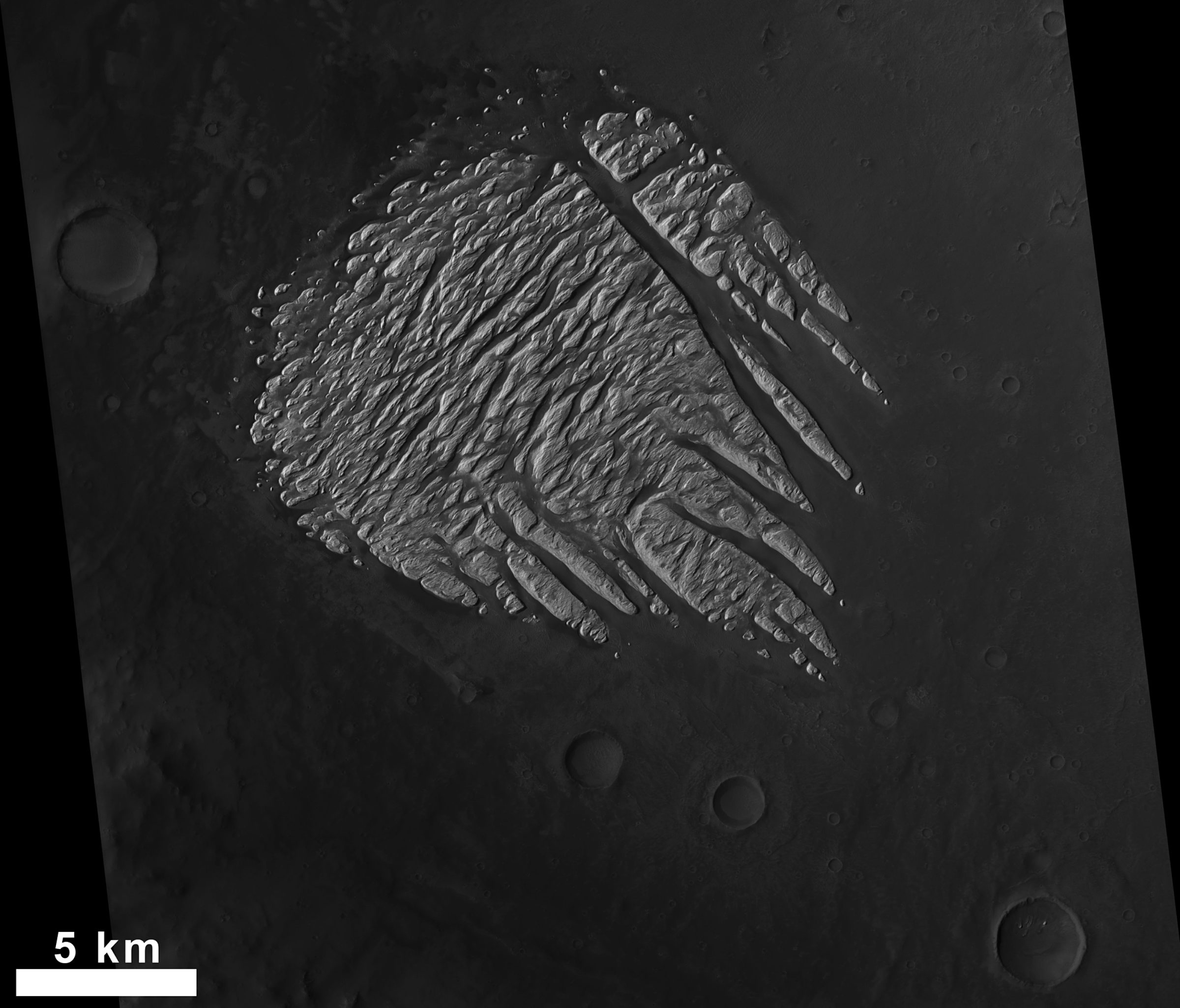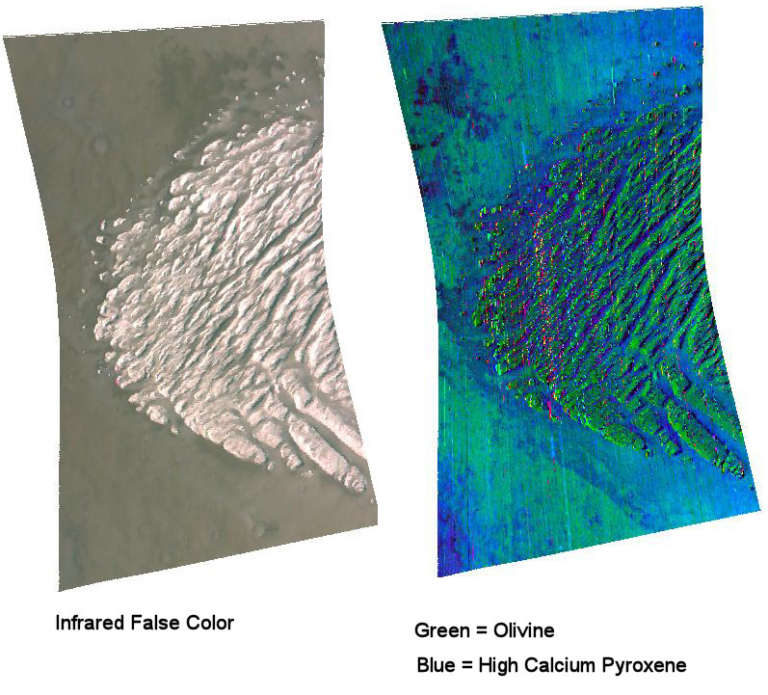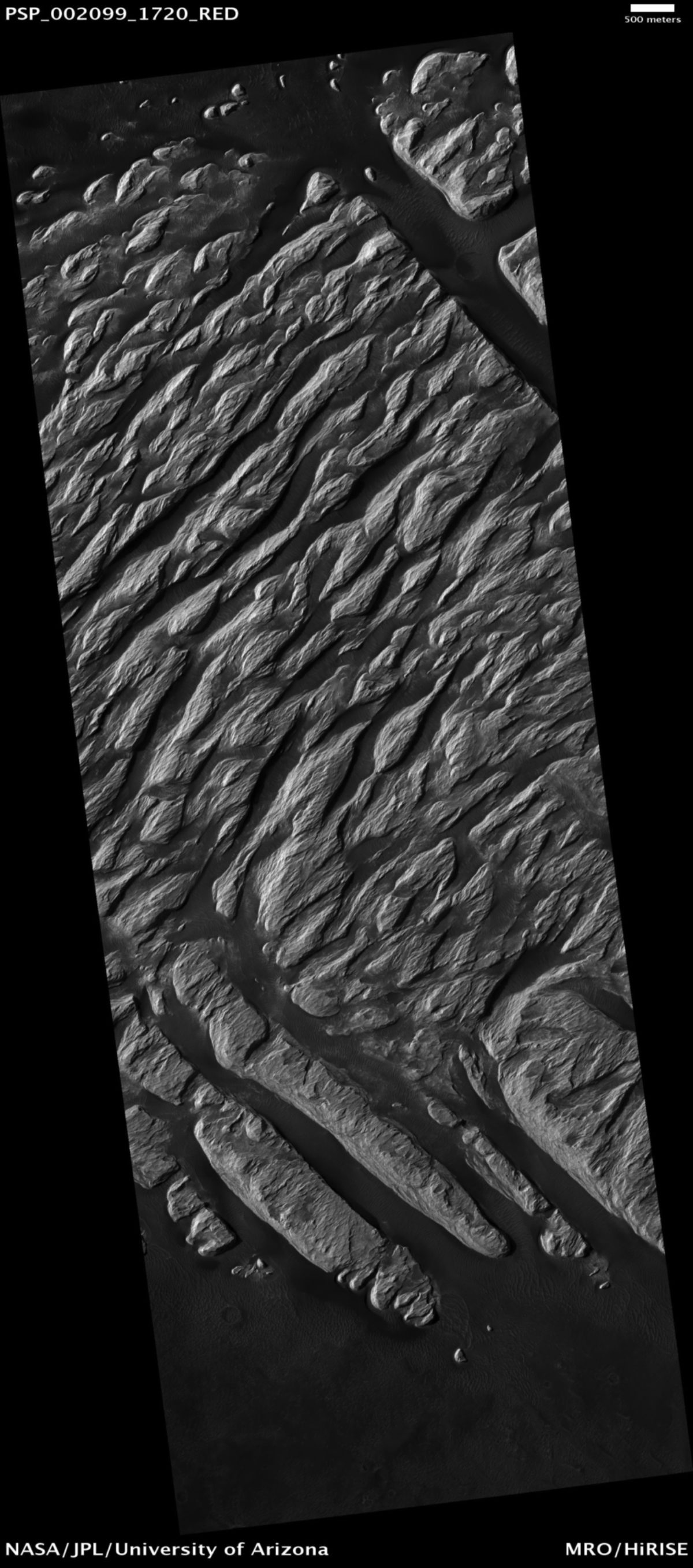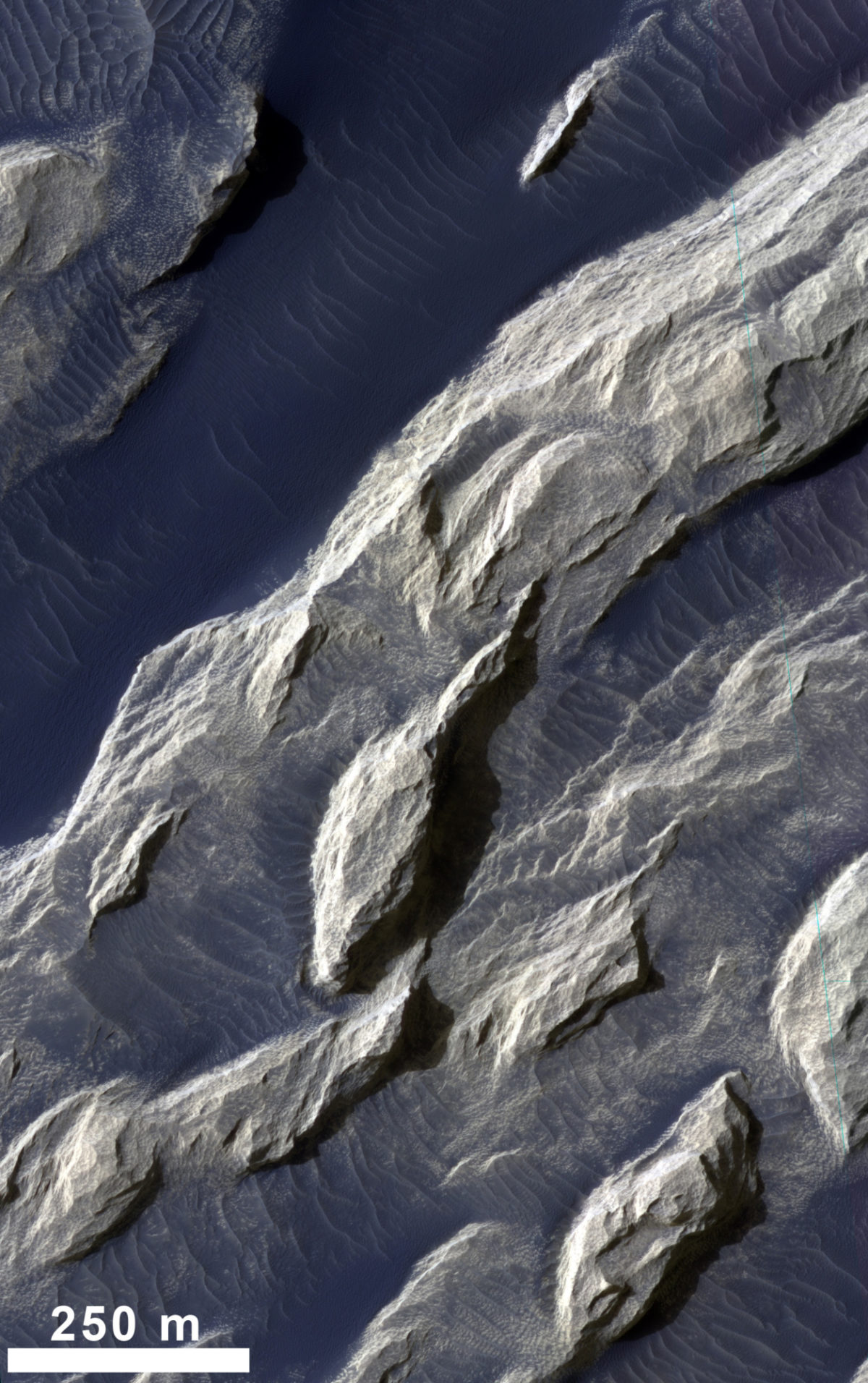Emily Lakdawalla • May 08, 2008
White Rock through the Ages: Mars Reconnaissance Orbiter (2006-present)
I apologize for the long hiatus in this White Rock series, but I hope this entry will be worth the wait. Mars Reconnaissance Orbiter is the latest and greatest of Earth's orbital emissaries to Mars. It's much bigger than either Mars Global Surveyor or Mars Odyssey and has a correspondingly huge radio dish, which it needs in order to return about a couple of Terabits of data every month. Actually, the dish is so large and the communications system so robust that the orbiter is capable of returning more data than all the instruments put together can collect, or so HiRISE principal investigator Alfred McEwen told me after I injudiciously used the adjective "bandwidth-hogging" to describe his instrument. (My apologies, Alfred!)
There are four main imaging instruments on Mars Reconnaissance Orbiter, each of which strikes a different compromise between five competing criteria: spectral resolution (how many different colors the image is taken in), spatial resolution (how small a feature is visible in an image), field of view (how large an area is visible in a single image), spatial coverage (how much of the planet will be imaged over the course of the mission), and temporal resolution (how frequently the same area is revisited):
- MARCI has very low spatial resolution but very high temporal resolution, capturing a global map of Mars every single day in seven colors, allowing scientists to monitor the weather.
- CTX has what would ordinarily be considered excellent spatial resolution of as high as 6 meters per pixel (until it's compared to HiRISE, see below), with image strips 30 kilometers wide. Its spectral resolution is poor (single color), but its areal coverage is great: over the course of the primary mission it will map 50% of Mars at about 6 meters per pixel, and extended missions might allow CTX to build up a full-globe data set. Many areas are being imaged more than once, for stereo and also to monitor for changes to the surface.
- CRISM has the greatest spectral resolution of any imaging spectrometer ever sent to Mars (or indeed anywhere else in the solar system except Earth), with as many as 560 colors per image. It does this at reasonably good spatial resolution of 18 meters per pixel, but will only cover a tiny fraction (about 2 percent) of the Martian surface by the end of the primary mission; each image covers an area roughly 10 kilometers wide and 10-40 kilometers long.
- HiRISE has a stupefyingly high resolution of roughly 30 centimeters per pixel, imaging Mars in a single color in skinny strips six kilometers wide. An even skinner central portion of the strip about 1.2 kilometers wide is viewed in four different colors. Like CRISM, it should image about 2 percent of the Martian surface by mission's end. A very, very small fraction of the surface, primarily at actual and proposed landing sites, will be viewed at least twice at different angles to permit the development of super-high-resolution digital elevation models.
I'm going to skip MARCI as I consider Mars Reconnaissance Orbiter's view of White Rock because, to really show you what MARCI is for, I should produce an animation showing what the sky looked like over White Rock over the course of the changing seasons. I'll just note that it's theoretically possible to do such a thing, but it probably wouldn't be worth the effort for the present exercise, as the data isn't archived in a particularly easy-to-use fashion. It would be worth the effort, though, to examine what the weather has looked like over time in the region surrounding the rovers, or over the Phoenix landing site.
So: on to CTX. Here's the CTX view of White Rock. I had to crop the top and bottom and do some pretty strong JPEG compression on this image to fit it under the 2-Megabyte limit of direct posting to our website; you can download the full-size image in PNG format here (28 MB).

If you compare to the view from Mars Global Surveyor MOC (which was at about double the resolution of 2.86 meters per pixel), you can see that CTX doesn't improve on MOC in terms of the detail it reveals; the two cameras achieve pretty similar levels of detail. So why bother sending another camera to Mars that can get pictures of pretty much the same quality that MOC did? Remember that it's not just about spatial resolution. CTX wins over MOC in terms of areal coverage. CTX can take in all of White Rock and some of the surrounding area in one photo, providing what will no doubt become the base map for my final summary post of this White Rock series. With MOC (and also THEMIS), more than one image was required to cover White Rock, and those images had to come from different orbits, possibly with different atmospheric conditions and even different seasons resulting in different lighting angles.
So CTX gives us the context. With that beautiful image to guide us, let's look at what CRISM can tell us about the composition of the rock. I've written before (see also here) about how the CRISM team has put together some neat ways to display their data so that even people who aren't spectroscopists or mineralogists can at least determine whether a place on Mars is compositionally interesting or not. Sadly, White Rock turns out to be pretty boring when viewed by CRISM. (When I was exchanging emails with the CRISM principal investigator Scott Murchie about this project, he seemed a bit chagrined that I'd be examining such a dull place, as it doesn't really demonstrate what CRISM is capable of.)

But a negative result can be an important one. We already knew from the TES, THEMIS, and OMEGA views of White Rock that the initial impression, that White Rock might be made of minerals evaporated from an ancient crater lake, was unlikely to be the correct interpretation. But CRISM's much higher spatial resolution allows it to look in the nooks and crannies of White Rock. If there was any real signature of water activity inside Pollack crater, CRISM should have been able to spot it; but all CRISM really sees is olivine and dust, so I'd say that we can really be very certain that White Rock is nothing more than cemented windblown sand and clay.
Even so, it's a pretty and dramatic landscape. And it's even prettier when viewed at the stunning level of detail afforded by HiRISE images. This first image is just to orient you, give you a sense of how much of White Rock is visible in one HiRISE observation, but even the one-Megabyte click-to-enlarge version is shown at only five percent of the full resolution.

Are you ready? Let's zoom in to an area near the northern edge of White Rock and view it in infrared false color. With the relatively light-colored materials of White Rock dominating the pixel values, the sand around White Rock looks positively blue.

When you zoom in -- and you really have to click on this one and wait for it to download so that you can see the amazing detail, which I'm only showing at half of the full resolution -- you can see that the sand that lies between the White Rock outcrops breaks up into mesmerizing patterns of intersecting dunes, dunes at a wide variety of scales, straight dunes, scaly dunes, dunes upon dunes. And, if you look at the White Rock material itself, you can suddenly realize that a lot of the odd and difficult-to-interpret texture (is it layering, or not?) is due to what look like little dunelets of sand marching across every horizontal surface (and even some of the non-horizontal ones). The same force that builds those dunes -- wind, and the sandpaper-like action of windblown sand -- has sculpted and faceted every exposed face of the White Rock outcrop, leaving it a patchwork of bright rock and dark dunes. The MOC team thought they saw layering in some of their images, but having seen this image, I'm no longer so sure; there may or may not be layers, but it's hard to tell because contrast of features within the White Rock material is overwhelmed by the contrast between White Rock and the wisps of dark sand that have drifted across it.
Like most other HiRISE images I've looked at, this one fascinates but also stupefies me. It shows me Mars at a scale that I could walk with my own two feet. I can reach out and touch it. It seems that, with my previous experience in field geology, I should be able to interpret what I see intuitively. But it's almost too close. I can't wrap my mind around the features I'm seeing and figure out what they mean about the geology of the region as a whole. I'd almost rather step back and look at Mars from the perspective of CTX. CTX is a scale at which I can look at features all over Mars, compare them, and build up some kind of global view of Mars' history. At the scale of HiRISE, everything is local; Mars breaks up into a world whose land area is, after all, as large as Earth's; and just imagine how many thousands, tens of thousands of geologists there are studying Earth at this scale! With the advent of HiRISE, it seems a Mars geologist could spend a whole career studying just one place -- Melas Chasma, say, or Nili Fossae, or the south polar layered deposits, and even then she'd only scratch the surface. Mars Reconnaissance Orbiter is the newest one at Mars, and it will remain the newest orbiter for many years; the only future Mars orbiter currently under construction is the tiny Chinese Yinghuo-1 (I'm not counting Phobos-Grunt, which will orbit Mars but will be focusing on its moon Phobos). So this wraps up my journey through the history of orbital views of one little place on Mars. I plan to write one last post attempting to bring all this together.
If you missed the previous installments, here they are: Mariner 9 - Viking - Mars Global Surveyor - 2001 Mars Odyssey - Mars Express
Let’s Go Beyond The Horizon
Every success in space exploration is the result of the community of space enthusiasts, like you, who believe it is important. You can help usher in the next great era of space exploration with your gift today.
Donate Today

 Explore Worlds
Explore Worlds Find Life
Find Life Defend Earth
Defend Earth


